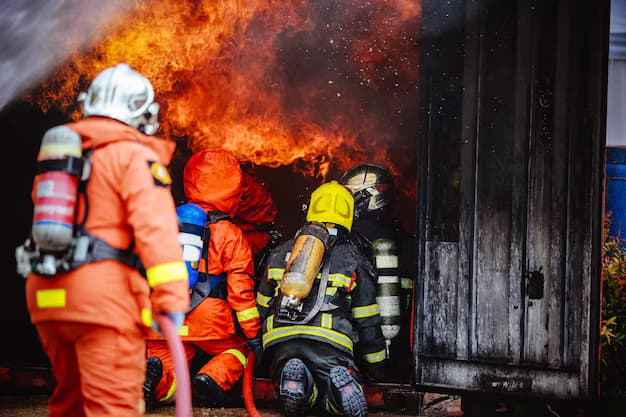Ensuring the safety of buildings and their occupants is a fundamental responsibility for property owners, managers, and developers. Passive fire protection west midlands plays a crucial role in safeguarding lives and minimizing property damage during a fire incident. In the West Midlands, adherence to legal standards and compliance regulations is essential to ensure that fire protection systems function effectively when needed most.
Understanding Passive Fire Protection
Passive fire protection refers to fire safety measures that are built into the structure of a building to prevent the spread of fire and smoke. Unlike active fire protection systems, such as sprinklers or alarms, passive systems do not require activation and function automatically. These systems are designed to compartmentalize a fire, protect structural elements, and allow safe evacuation.
Components of Passive Fire Protection
- Fire-Resistant Walls and Floors
- Fire-resistant walls and floors are critical for containing fire within designated areas. These structures are designed to resist heat and flames for a specific duration, giving occupants more time to evacuate and limiting fire spread.
- Fire Doors
- Fire doors are specially constructed to withstand fire and smoke, preventing them from spreading between rooms or compartments. Proper installation and maintenance are essential for their effectiveness.
- Firestopping Materials
- Firestopping involves sealing gaps, joints, and openings in walls, floors, and ceilings. Materials such as intumescent sealants, collars, and wraps expand when exposed to heat, blocking the passage of fire and smoke.
- Structural Fire Protection
- Structural elements like steel beams and columns can weaken under extreme heat. Passive fire protection systems, including fireproof coatings and encasements, help maintain the integrity of these structures during a fire.
Legal Standards for Passive Fire Protection in the West Midlands
Compliance with fire safety regulations is not optional. Legal standards are in place to ensure that buildings are designed, constructed, and maintained to minimize the risk of fire.
Building Regulations
The UK Building Regulations outline mandatory requirements for fire safety. Part B of the regulations focuses specifically on fire safety measures, including both active and passive systems. Key requirements include:
- Adequate compartmentation to prevent fire and smoke spread.
- Installation of fire doors in high-risk areas.
- Proper firestopping in service penetrations and structural gaps.
- Use of fire-resistant materials for structural components.
Regulatory Reform (Fire Safety) Order 2005
The Regulatory Reform (Fire Safety) Order 2005 applies to England and Wales, including the West Midlands. It places responsibility on the "responsible person," usually the building owner or manager, to ensure fire safety measures are in place. This includes:
- Conducting risk assessments to identify potential hazards.
- Implementing passive fire protection measures where required.
- Maintaining and regularly inspecting fire safety systems.
British Standards
British Standards provide detailed guidelines for designing and maintaining passive fire protection systems. Key standards include:
- BS 476: Fire tests on building materials and structures.
- BS 9999: Code of practice for fire safety in the design, management, and use of buildings.
- BS EN 13501: Classification of construction products and building elements based on fire performance.
Ensuring Compliance in Existing Buildings
Compliance is not limited to new construction. Existing buildings also need to meet fire safety standards. Regular inspections and maintenance are critical for identifying deficiencies and ensuring that passive fire protection measures are effective.
Fire Risk Assessments
A thorough fire risk assessment evaluates the likelihood and potential impact of a fire within a building. This process identifies areas where passive fire protection may be inadequate and recommends necessary improvements.
Maintenance and Upgrades
Maintaining fire-resistant structures, doors, and firestopping materials is essential. Over time, materials may degrade, gaps can develop, and doors may fail to close properly. Upgrades and repairs should follow current regulations and standards to maintain compliance.
Documentation and Record-Keeping
Proper documentation demonstrates compliance with legal standards and provides evidence during inspections. Records should include installation certificates, maintenance logs, and risk assessment reports.
Common Challenges in Passive Fire Protection
Despite the importance of passive fire protection, several challenges can hinder compliance and effectiveness.
Improper Installation
Incorrect installation of fire doors, sealants, or structural coatings can compromise the effectiveness of passive fire protection systems. Professional installation and adherence to manufacturer guidelines are critical.
Building Modifications
Renovations or alterations can create gaps in fire-resistant structures or disrupt compartmentation. Any modifications should be carefully assessed to ensure that fire safety measures remain intact.
Lack of Awareness
Some building owners and managers may underestimate the importance of passive fire protection. Raising awareness and providing training on legal standards can help maintain a safe environment.
Benefits of Effective Passive Fire Protection
Investing in high-quality passive fire protection offers numerous benefits:
- Enhanced Safety: Proper systems slow the spread of fire, protecting lives and reducing injuries.
- Structural Integrity: Fireproof coatings and resistant materials help maintain the stability of buildings.
- Regulatory Compliance: Meeting legal standards avoids penalties and potential legal liabilities.
- Insurance Advantages: Buildings with compliant fire protection may benefit from lower insurance premiums.
Conclusion
Passive fire protection is a cornerstone of building safety, and strict adherence to legal standards is essential in the West Midlands. From fire-resistant walls and floors to properly maintained fire doors and firestopping systems, every component plays a vital role in protecting lives and property. Compliance with building regulations, the Regulatory Reform Order, and British Standards ensures that passive fire protection systems are effective and reliable. Regular assessments, maintenance, and awareness are key to sustaining a safe environment. For expert guidance and implementation of passive fire protection in the West Midlands, Tblfireprotection provides comprehensive solutions to help buildings meet and exceed legal standards.





Comments